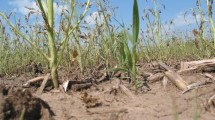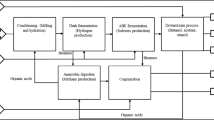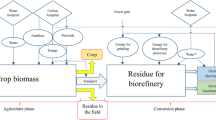Abstract
The amount of corn stover and wheat straw that can be sustainably collected in North Carolina was estimated to be 0.64 and 0.16 million dry t/yr, respectively. More than 80% of these crop residues are located in the coastal area. The bioethanol potential from corn stover and wheat straw was estimated to be about 238 million L (63 million gal/yr) in North Carolina. The future location of ethanol plant in North Carolina was estimated based on feedstock demand and collection radius. It is possible to have four ethanol plants with feedstock demand of 400, 450, 500, and 640 dry t/d. The collection radii for these four ethanol plants are 46, 60, 42, and 67 km (28, 37, 26, and 42 miles), respectively. The best location for a bioethanol plant includes four counties (Beaufort, Hyde, Tyrrell, and Washington) with feedstock demand of 500 t/d and collection radius about 26 mile.
Similar content being viewed by others
References
Li, Y., Ruan, R. R., Chen, P. L., Liu, Z., and Pan, X. (2004), Trans. ASAE 47(3), 821–825.
Shahbazi, A., Li, Y., and Mims, M. R. (2005), Appl. Biochem. Biotechnol. 121–124, 973–988.
Kim, T. H., Kim, J. S., Sunwoo, S., and Lee, Y. Y. (2003), Bioresour. Technol. 90(1), 39–47.
William, E. K. and Holtzapple, M. T. (2000), Biomass Bioener. 18, 189–199.
NREL website. http://www.nrel.gov. Accessed on 02/02/2005.
Kadam, K. L. and McMillan, J. D. (2003), Bioresour. Technol. 88, 17–25.
Perlack, R. D. and Turhollow, A. F. (2003), Energy 28, 1395–1403.
North Carolina Department of Agriculture and Consumer Services (2005), http://www.ncagr.com/stats/cnty_est/cnty_est.htm. Accessed on 03/09/2005.
Arkansas Agriculture. http://www.aragriculture.org/ageningeering/harvesting/ soybeans/default.asp. Accessed on 04/09/2005
Walsha, M. E., Perlacka, R. L., Ugarteb, D. T., et al. http://bioenergy.ornl.gov/resource data/. Accessed on 03/09/2005.
State Library of North Carolina, North Carolina County Development. http:// statelibrary.dcr.state.nc.us/iss/gr/counties.htm. Accessed on 03/09/2005.
NREL website, Theoretical Ethanol Yield Calculator, http://www.eere.energy.gov/ biomass/ethanol_yield_calculator.html. Accessed on 09/01/2005.
Kerstetter, J. D. and Lyons, J. K. (2001), http://www.newuses.org/pdf/WSUCEEP 2001084.pdf. Accessed on 01/02/2005.
Author information
Authors and Affiliations
Corresponding author
Rights and permissions
About this article
Cite this article
Shahbazi, A., Li, Y. Availability of crop residues as sustainable feedstock for bioethanol production in North Carolina. Appl Biochem Biotechnol 129, 41–54 (2006). https://doi.org/10.1385/ABAB:129:1:41
Issue Date:
DOI: https://doi.org/10.1385/ABAB:129:1:41




